| William Thomas Lyons was the eldest son of William and Martha Lyons. William Lyons and Martha Campbell were married on 12th June 1879 in Belfast.
|
| William Lyons was born on 25th July 1880 in Belfast. He was the oldest of six children.
|
| Family: William Lyons, Martha Lyons, William Thomas Lyons (born 25th July 1880, Belfast), Martha Isobel Lyons (born 21st September 1882, Belfast), John Lyons (born 2nd August 1886, Belfast), Catherine Jane Lyons (born 17th October 1888, Loughgall), Alice Elizabeth Lyons (born 29th January 1891, Loughgall), Agnes Mary Lyons (born 18th January 1894, Loughgall).
|
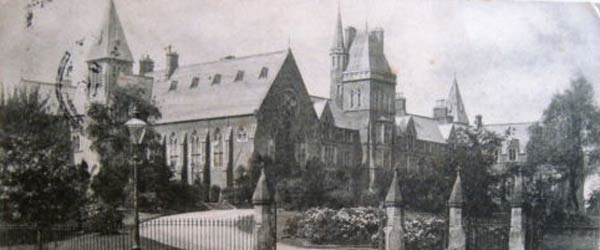
|
| William went to the Methodist College in Belfast.
|
| It seems the family moved to the Loughgall area of County Armagh about 1887.
|
| William continued his education at the Royal School Dungannon in 1899.
|
| By the time of the 1901 census, William Thomas Lyons was a boarder at house 12 in Mountcollyer Avenue, Duncairn Ward, Belfast. He was 20 years old and gives his occupation as Wholesale Stationery Book - Keeper (Drapery). He worked in the counting house of Messrs James Lindsay & Co Ltd, Donegal Place, where he held the position of foreign correspondent for 11½ years. William spoke four languages, and was particularly fluent in French. His 18 year old sister Martha Lyons was boarding in the same house.
|
| The 1901 census records the family living in Clontyclay, Killymann, County Armagh. William's father was born in county Galway. He was a Railway Agent.
|
| The 1911 census records Williams as boarding at Glenravel Street, Dock Ward, Belfast. He was thirty years old. He gave his occupation as Corresponding Clerk. His 20 year old sister Alice Lyons was boarding in the same house.
|
| The 1911 census also shows his parents were still living in Clontyclay, Killymann, County Armagh. His father was a Great Northern Railway Station Master.
|
| Around 1912, he became an accountant and office manager of the Jaffe Spinning Company Limited, Newtownards Road, and became assistant secretary
|
| He held several diplomas for accountancy and commercial work. He also taught bookkeeping in the Municipal Technical Institute, Belfast and the Bangor and Ballyclare Technical Schools.
|
| He was also well known as an elocutionist, being one of Mr Pyper's gold and silver medallists.
|
| William was a member of Masonic Lodge No. 372.
|
| Captain Lyons joined the Belfast University Officer Training Corps in May 1913, and became a first-class signaller in November 1914.
|
| 1914
|
| William Lyons obtained a commission in the Army in December 1914. He joined the battalion; them commanded by a distinguished County Derry officer, Colonel W R H Beresford-Ash, at Bournemouth.
|

|
| 1915
|
| William was promoted to the rank of Lieutenant on 5th June 1915.
|
| In July 1915, he qualified with first class honours at the Hythe School of Musketry in England and was subsequently given command of a company.
|
| From the Belfast Newsletter dated 1st September 1915:
|

|
| Lieutenant W T Lyons, who prior to the war was in business in Belfast, has been promoted captain in the 10th (Service) Battalion Royal Welsh Fusiliers.
|
| From the Belfast Newsletter dated 30th September 1915:
|

|
| Captain W T Lyons, an old Methodist College and Dungannon Royal School boy, has been gazetted to the adjutancy of the 19th Royal Welsh Fusiliers.
|
| From the Tyrone Courier dated 7th October 1915:
|

|
| Captain W T Lyons, an old Dungannon Royal School boy, has been gazetted to the adjutancy of the 10th Royal Welsh Fusiliers.
|
| Captain Lyons was appointed adjutant to the battalion in September 1915.
|
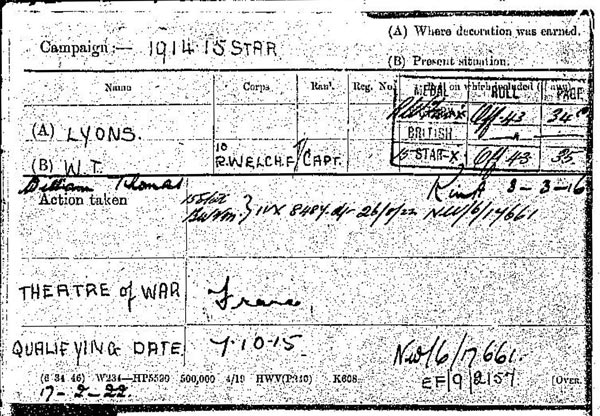
|
| Captain Lyons arrived in France with the Royal Welsh Fusiliers on 7th October 1915.
|
| 1916
|
| In early March 1916, the brigade was brought up from their rest period to retake from the Germans some trenches taken in the previous month. It was during this attack, which was entirely successful, that Captain Lyons was killed. He was in a dugout with his Colonel and second-in-command when a shell landing on top of the dugout, killing all inside.
|
| Captain William Lyons was serving with the 10th (Service) Battalion of the Royal Welsh Fusiliers when he was killed in action near Ypres on 3 March 1916. He was 35 years of age.
|
| From the Belfast Newsletter dated 8th March 1916 :
|
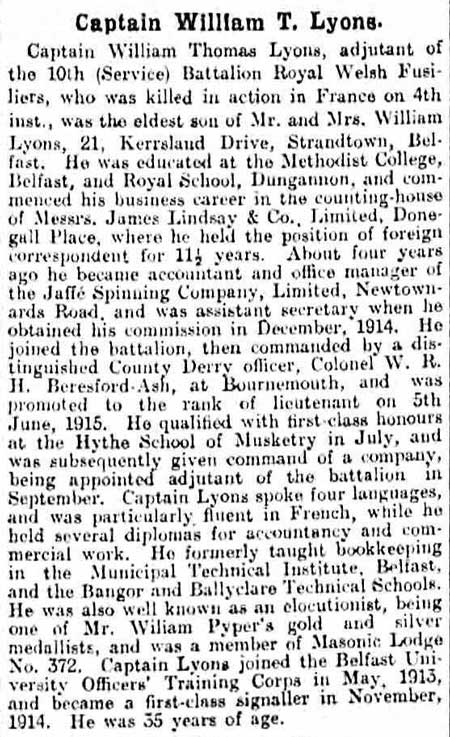
|
| Captain William Thomas Lyons, adjutant of the 10th (Service) Battalion Royal Welsh Fusiliers, who was killed in action in France on 4th March 1916, was the eldest son of Mr and Mrs William Lyons, 21 Kerrsland Drive, Strandtown, Belfast. He was educated at Methodist College, Belfast and Royal School, Dungannon, and commenced his business career in the counting house of Messrs James Lindsay & Co Ltd, Donegal Place, where he held the position of foreign correspondent for 11½ years. About four years ago he became accountant and office manager of the Jaffe Spinning Company Limited, Newtownards Road, and was assistant secretary when he obtained his commission in December 1914. He joined the battalion; them commanded by a distinguished County Derry officer, Colonel W R H Beresford-Ash, at Bournemouth and he was promoted to the rank of Lieutenant on 5th June 1915. He qualified with first class honours at the Hythe School of Musketry in July, and was subsequently given command of a company, being appointed adjutant to the battalion in September. Captain Lyons spoke four languages, and was particularly fluent in French, while he held several diplomas for accountancy and commercial work. He formerly taught bookkeeping in the Municipal Technical Institute, Belfast and the Bangor and Ballyclare Technical Schools. He was also well known as an elocutionist, being one of Mr Pyper's gold and silver medallists, and was a member of Masonic Lodge No. 372. Captain Lyons joined the Belfast University Officer Training Corps in May 1913, and became a first-class signaller in November 1914. He was 35 years of age.
|
| From the Tyrone Courier dated 9th March 1916:
|

|
| Captain William Thomas Lyons, adjutant of the 10th Welsh Fusiliers, reported killed in action on the Western Front on the 4th March, is an old Dungannon Royal School boy.
|
| From the Belfast Newsletter dated 11th March 1916 :
|
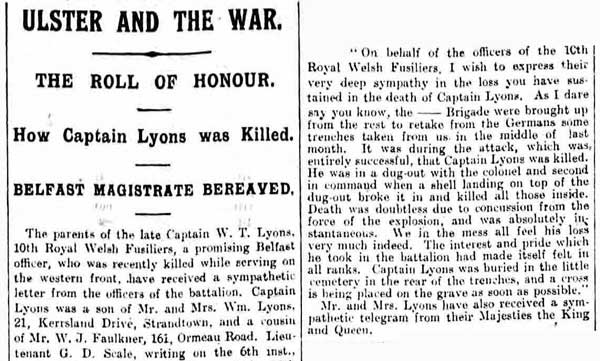
|
| The parents of the late Captain W T Lyons, 10th Royal Welsh Fusiliers, a promising Belfast officer, who was recently killed while serving on the western front, have received a sympathetic letter from the officers of the battalion. Captain Lyons was a son of Mr and Mrs William Lyons, 21 Kerrsland Drive, Strandtown, and a cousin of Mr W J Faulkner, 161 Ormeau Road. Lieutenant G D Scale, writing on the 6th March says:-
|
| 'On behalf of the officers of the 10th Royal Welsh Fusiliers, I wish to express their very deep sympathy in the loss you have sustained in the death of Captain Lyons. As I dare say you know, the Brigade were brought up from the rest to retake from the Germans some trenches taken from us in the middle of last month. It was during the attack, which was entirely successful, that Captain Lyons was killed. He was in a dugout with the colonel and second-in-command when a shell landing on top of the dugout broke it in and killed all inside. Death was doubtless due to concussion from the force of the explosion, and was absolutely instantaneous. We in the mess all feel his loss very much indeed. The interest and pride in which he took in the Battalion had made itself felt in all ranks. Captain Lyons was buried in the little cemetery in the rear of the trenches, and a cross is being placed on the grave as soon as possible.'
|
| Mr and Mrs Lyons have also received a sympathetic telegram from their Majesties the King and Queen.
|
| From the Belfast Newsletter dated 17th June 1916 :
|

|
| Captain W T Lyons, Royal Welsh Fusiliers (killed), mentioned in Sir Douglas Haig's despatch, was the eldest son of Mr and Mrs William Lyons, 21 Kerrsland Drive, Strandtown, Belfast.
|
| Memorials
|
| Captain William Lyons is buried in Spoilbank Cemetery, five kilometres south of Ypres town centre.
|
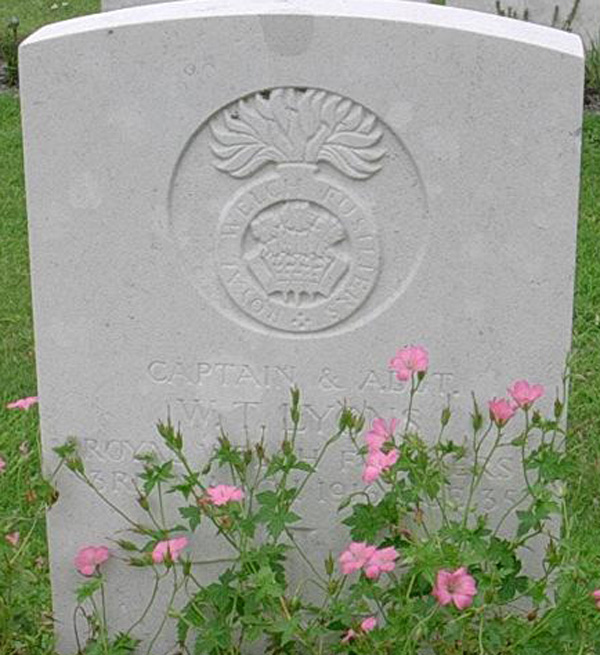
|
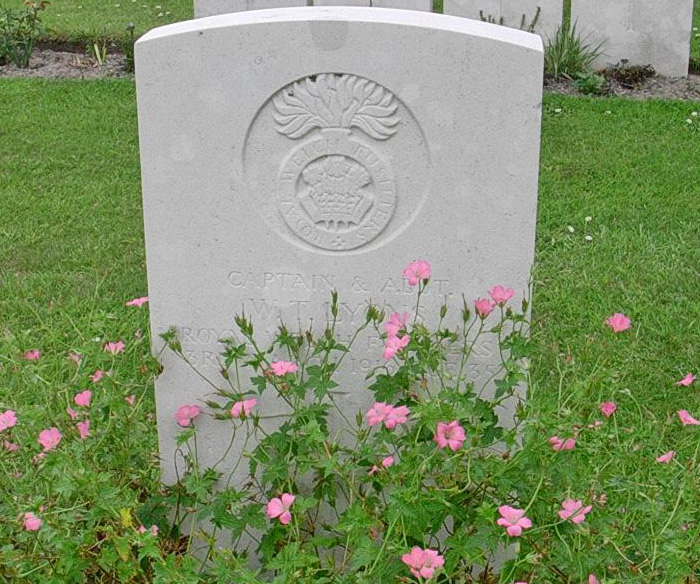
|
| Captain William Lyons is one of two W T Lyons listed on Queens University War Memorial.
|

|
| The CWGC record Captain William Thomas Lyons as the son of Martha Lyons of 21 Kerrsland Drive, Strandtown, Belfast, and the late William Lyons.
|
| Many thanks to Paul Kerr and the Royal School Dungannon for his research and the information provided.
|

|
